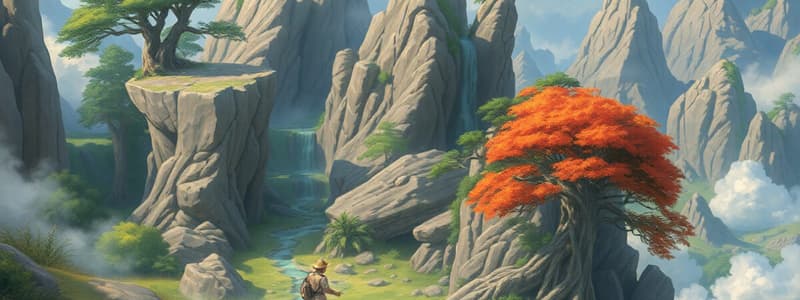Podcast
Questions and Answers
What is the primary focus of community ecology?
What is the primary focus of community ecology?
- Population growth rates of the same species
- Abiotic factors affecting individual organisms
- Interactions between different species and their effects on populations (correct)
- The study of energy flow within an ecosystem
Which factor is NOT considered an abiotic component of an ecosystem?
Which factor is NOT considered an abiotic component of an ecosystem?
- Nutrients
- Water
- Plants (correct)
- Light
What ecological phenomenon describes the rapid temperature change in water layers?
What ecological phenomenon describes the rapid temperature change in water layers?
- Thermocline (correct)
- Hypoxia
- Ecotone
- Microclimate
Which statement is true regarding endemic species?
Which statement is true regarding endemic species?
The concept of ecotones refers to:
The concept of ecotones refers to:
What impact does more forest cover have on the environment?
What impact does more forest cover have on the environment?
Which biome is characterized by low precipitation and high temperatures?
Which biome is characterized by low precipitation and high temperatures?
What can lead to ecological changes and evolutionary change?
What can lead to ecological changes and evolutionary change?
Flashcards
Ecology
Ecology
The study of how organisms interact with their environment.
Population Ecology
Population Ecology
The study of factors that influence populations of the same species.
Community Ecology
Community Ecology
The study of interactions between different species and their effects on communities.
Ecosystem Ecology
Ecosystem Ecology
Signup and view all the flashcards
Climate
Climate
Signup and view all the flashcards
Microclimate
Microclimate
Signup and view all the flashcards
Abiotic Factors
Abiotic Factors
Signup and view all the flashcards
Biotic Factors
Biotic Factors
Signup and view all the flashcards
Study Notes
Ecology
- Ecology: Study of an organism and its environment
- Population ecology: Factors affecting populations (same species)
- Community ecology: Species interactions and effects on populations/communities
- Ecosystem ecology: Energy and chemical flow between organisms and environment
- Climate: Depends on temperature, precipitation, wind, and sunlight (global-solar energy, local-seasons)
- Global air circulation changes caused by radiation at the equator
- Seasonal cycles related to Earth's tilt
- Microclimates influenced by shade, wind patterns, and evaporative patterns
- Abiotic factors (non-living): pH, temperature, water, wind, light, nutrients
- Biotic factors (living): Animals, plants, insects
Ecological Change
- Ecological change alters the outcome of ecological interactions
- Evolutionary change alters selective pressures
- Example: Guppies evolved under low (reduce algae) or high (increase algae) predator conditions
Biomes
- Global climate change caused by burning fossil fuels, leading to extreme weather events/temperature changes
- Terrestrial biome: Species convergence, examples include desert, savanna, chaparral, tropical forests, grassland, tundra, and differences in precipitation
- Ecotones: Boundaries between biomes
- Aquatic biomes: Marine (3% salt), freshwater (0.1% salt), divided into zones (pelagic, photic, aphotic, abyssal, benthic)
Aquatic Biomes
- Aquatic biomes - marine 3% salt and freshwater 0.1% salt. Divided into different zones
- Pelagic: photic (light reaches) and aphotic (no light)
- Abyssal: Below aphotic (2,000-6,000 m below)
- Benthic: Sediment and organic matter below
Other Important Concepts
- Thermocline: Layer of rapid temperature change (warm upper water and cold lower water). Specific temperatures for winter, spring, and summer layers.
- Hypoxia: Low oxygen in freshwater
- Endemic species: Found in only one geographical area (e.g., Kangaroo, Saguaro cactus) at specific elevation
- Higher elevation conditions: High temperatures, low oxygen, dry conditions, high UV radiation
Studying That Suits You
Use AI to generate personalized quizzes and flashcards to suit your learning preferences.



